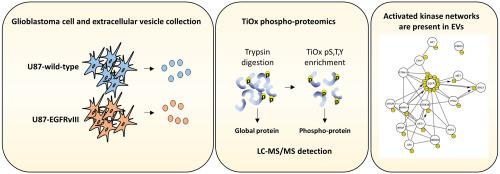Journal of Proteomics ( IF 2.8 ) Pub Date : 2020-12-08 , DOI: 10.1016/j.jprot.2020.104076 Irene V Bijnsdorp 1 , Tim Schelfhorst 2 , Mark Luinenburg 3 , Frank Rolfs 4 , Sander R Piersma 2 , Richard R de Haas 2 , Thang V Pham 2 , Connie R Jimenez 2

|
Cancer cells secrete extracellular vesicles (EVs) that contain molecular information, including proteins and RNA. Oncogenic signalling can be transferred via the cargo of EVs to recipient cells and may influence the behaviour of neighbouring cells or cells at a distance. This cargo may contain cancer drivers, such as EGFR, and also phosphorylated (activated) components of oncogenic signalling cascades. Till date, the cancer EV phosphoproteome has not been studied in great detail. In the present study, we used U87 and U87EGFRvIII cells as a model to explore EV oncogenic signalling components in comparison to the cellular profile. EVs were isolated using the VN96 ME-kit and subjected to LC-MS/MS based phosphoproteomics and dedicated bioinformatics. Expression of (phosphorylated)-EGFR was highly increased in EGFRvIII overexpressing cells and their secreted EVs. The increased phosphorylated proteins in both cells and EVs were associated with activated components of the EGFR-signalling cascade and included EGFR, AKT2, MAPK8, SMG1, MAP3K7, DYRK1A, RPS6KA3 and PAK4 kinases. In conclusion, EVs harbour oncogenic signalling networks including multiple activated kinases including EGFR, AKT and mTOR.
Significance
Extracellular vesicles (EVs) are biomarker treasure troves and are widely studied for their biomarker content in cancer. However, little research has been done on the phosphorylated protein profile within cancer EVs. In the current study, we demonstrate that EVs that are secreted by U87-EGFRvIII mutant glioblastoma cells contain high levels of oncogenic signalling networks. These networks contain multiple activated (phosphorylated) kinases, including EGFR, MAPK, AKT and mTOR.
中文翻译:

以胶质母细胞瘤-EGFRVIII细胞为模型,磷酸化蛋白质组学揭示分泌细胞外囊泡中致癌信号的可行性
癌细胞分泌细胞外囊泡 (EV),其中包含分子信息,包括蛋白质和 RNA。致癌信号可以通过 EV 的货物转移到受体细胞,并可能影响邻近细胞或远处细胞的行为。这种货物可能含有癌症驱动因子,如 EGFR,以及致癌信号级联的磷酸化(活化)成分。迄今为止,尚未对癌症 EV 磷酸化蛋白质组进行非常详细的研究。在本研究中,我们使用 U87 和 U87EGFRvIII 细胞作为模型来探索 EV 致癌信号成分与细胞谱的比较。使用 VN96 ME-kit 分离 EV,并进行基于 LC-MS/MS 的磷酸化蛋白质组学和专用生物信息学。(磷酸化)-EGFR 的表达在 EGFRvIII 过表达细胞及其分泌的 EV 中高度增加。细胞和 EV 中增加的磷酸化蛋白与 EGFR 信号级联的激活成分相关,包括 EGFR、AKT2、MAPK8、SMG1、MAP3K7、DYRK1A、RPS6KA3 和 PAK4 激酶。总之,EV 具有致癌信号网络,包括多种激活的激酶,包括 EGFR、AKT 和 mTOR。
意义
细胞外囊泡 (EV) 是生物标志物的宝库,因其在癌症中的生物标志物含量而被广泛研究。然而,关于癌症 EV 中磷酸化蛋白谱的研究很少。在目前的研究中,我们证明了由 U87-EGFRvIII 突变胶质母细胞瘤细胞分泌的 EV 含有高水平的致癌信号网络。这些网络包含多种活化(磷酸化)激酶,包括 EGFR、MAPK、AKT 和 mTOR。











































 京公网安备 11010802027423号
京公网安备 11010802027423号